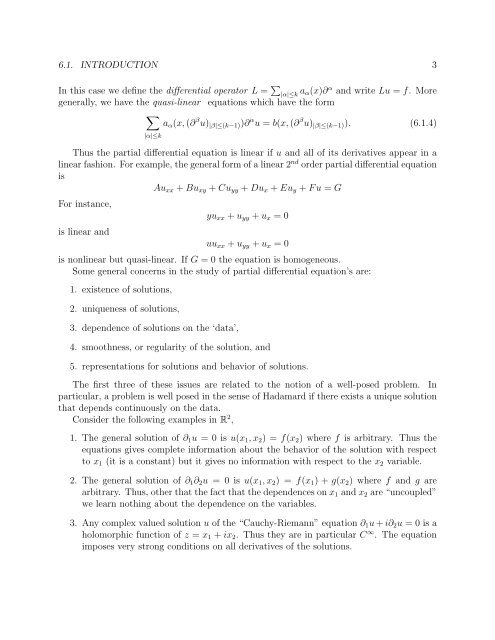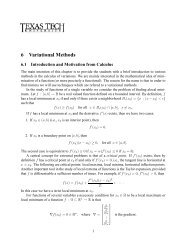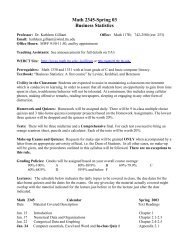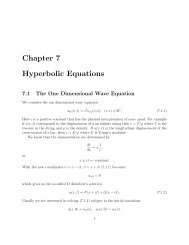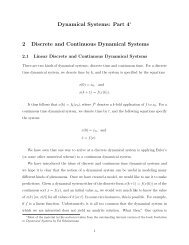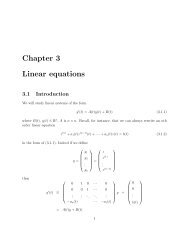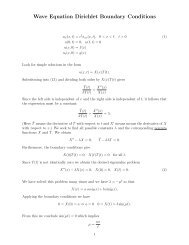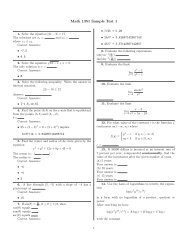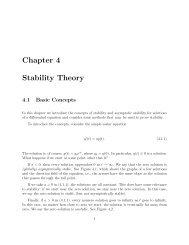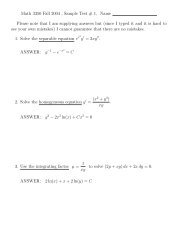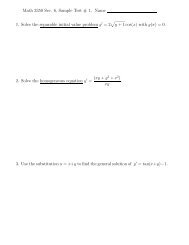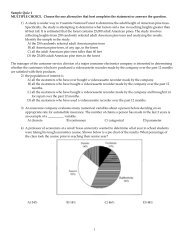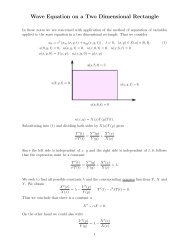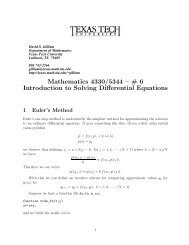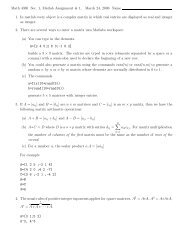Chapter 6 Partial Differential Equations
Chapter 6 Partial Differential Equations
Chapter 6 Partial Differential Equations
Create successful ePaper yourself
Turn your PDF publications into a flip-book with our unique Google optimized e-Paper software.
6.1. INTRODUCTION 3<br />
In this case we define the differential operator L = ∑ |α|≤k a α(x)∂ α and write Lu = f. More<br />
generally, we have the quasi-linear equations which have the form<br />
∑<br />
a α (x, (∂ β u) |β|≤(k−1) )∂ α u = b(x, (∂ β u) |β|≤(k−1) ). (6.1.4)<br />
|α|≤k<br />
Thus the partial differential equation is linear if u and all of its derivatives appear in a<br />
linear fashion. For example, the general form of a linear 2 nd order partial differential equation<br />
is<br />
Au xx + Bu xy + Cu yy + Du x + Eu y + Fu = G<br />
For instance,<br />
yu xx + u yy + u x =0<br />
is linear and<br />
uu xx + u yy + u x =0<br />
is nonlinear but quasi-linear. If G = 0 the equation is homogeneous.<br />
Some general concerns in the study of partial differential equation’s are:<br />
1. existence of solutions,<br />
2. uniqueness of solutions,<br />
3. dependence of solutions on the ‘data’,<br />
4. smoothness, or regularity of the solution, and<br />
5. representations for solutions and behavior of solutions.<br />
The first three of these issues are related to the notion of a well-posed problem. In<br />
particular, a problem is well posed in the sense of Hadamard if there exists a unique solution<br />
that depends continuously on the data.<br />
Consider the following examples in R 2 ,<br />
1. The general solution of ∂ 1 u =0isu(x 1 ,x 2 )=f(x 2 ) where f is arbitrary. Thus the<br />
equations gives complete information about the behavior of the solution with respect<br />
to x 1 (it is a constant) but it gives no information with respect to the x 2 variable.<br />
2. The general solution of ∂ 1 ∂ 2 u =0isu(x 1 ,x 2 )=f(x 1 )+g(x 2 ) where f and g are<br />
arbitrary. Thus, other that the fact that the dependences on x 1 and x 2 are “uncoupled”<br />
we learn nothing about the dependence on the variables.<br />
3. Any complex valued solution u of the “Cauchy-Riemann” equation ∂ 1 u + i∂ 2 u = 0 is a<br />
holomorphic function of z = x 1 + ix 2 . Thus they are in particular C ∞ . The equation<br />
imposes very strong conditions on all derivatives of the solutions.


